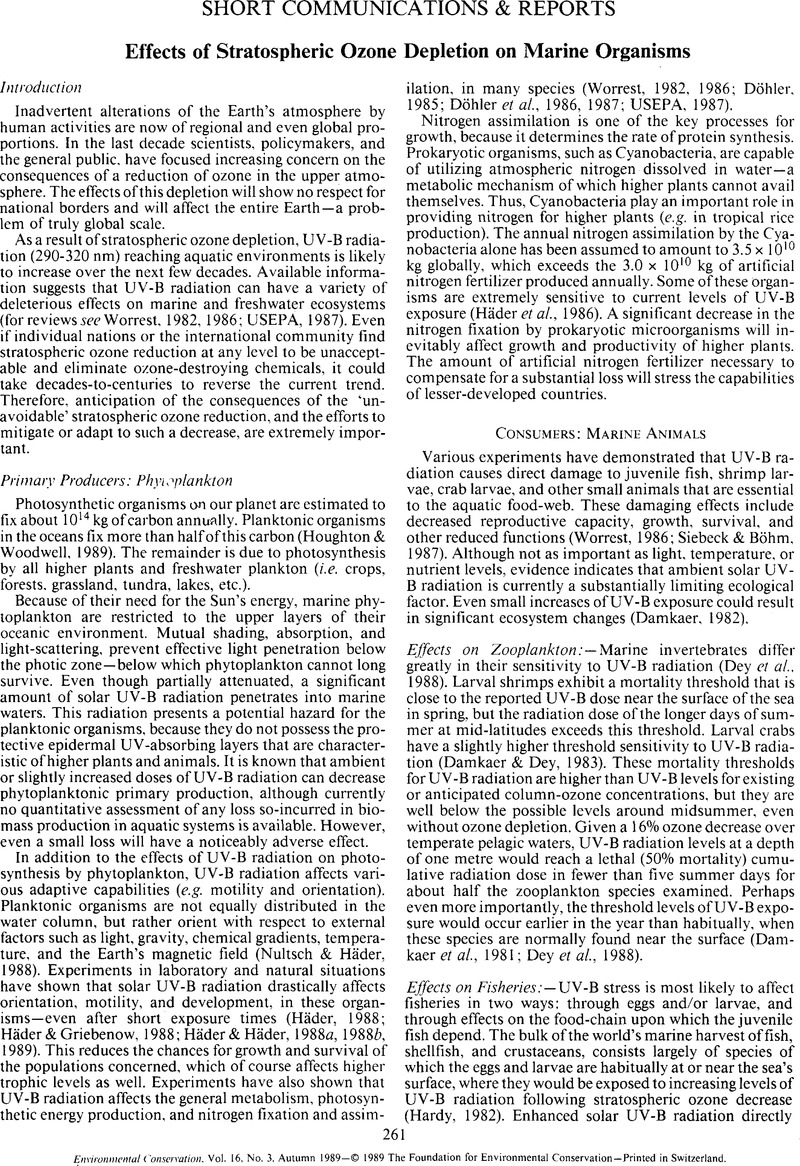Crossref Citations
This article has been cited by the following publications. This list is generated based on data provided by Crossref.
Doughty, Michael J.
1991.
Biophysics of Photoreceptors and Photomovements in Microorganisms.
p.
73.
Gerber, Sabine
and
Häder, Donat-P.
1992.
UV effects on photosynthesis, proteins and pigmentation in the flagellate Euglena gracilis: Biochemical and spectroscopic observations.
Biochemical Systematics and Ecology,
Vol. 20,
Issue. 6,
p.
485.
Mayer, S.
and
Haines, A.
1992.
Airs, waters, places, and doctors..
BMJ,
Vol. 304,
Issue. 6825,
p.
502.
Holligan, P.M.
and
Reiners, W.A.
1992.
The Ecological Consequences of Global Climate Change.
Vol. 22,
Issue. ,
p.
211.
Gerber, Sabine
and
Häder, Donat-P.
1993.
Effects of solar irradiation on motility and pigmentation of three species of phytoplankton.
Environmental and Experimental Botany,
Vol. 33,
Issue. 4,
p.
515.
Hargraves, P.E.
Zhang, J.
Wang, R.
and
Shimizu, Y.
1993.
Growth characteristics of the diatoms Pseudonitzschia pungens and P. fraudulenta exposed to ultraviolet radiation.
Hydrobiologia,
Vol. 269-270,
Issue. 1,
p.
207.
Hargraves, P. E.
Zhang, J.
Wang, R.
and
Shimizu, Y.
1993.
Twelfth International Diatom Symposium.
p.
207.
Herndl, Gerhard J.
Müller-Niklas, Gerald
and
Frick, Jürgen
1993.
Major role of ultraviolet-B in controlling bacterioplankton growth in the surface layer of the ocean.
Nature,
Vol. 361,
Issue. 6414,
p.
717.
Kock, Karl-Hermann
1994.
Fishing and conservation in southern waters Karl-Hermann Kock.
Polar Record,
Vol. 30,
Issue. 172,
p.
3.
Gleason, D. F.
and
Wellington, G. M.
1995.
Variation in UVB sensitivity of planula larvae of the coral Agaricia agaricites along a depth gradient.
Marine Biology,
Vol. 123,
Issue. 4,
p.
693.
Häder, D.-P.
1996.
Light as an Energy Source and Information Carrier in Plant Physiology.
p.
231.
Kaiser, E
and
Herndl, G J
1997.
Rapid Recovery of Marine Bacterioplankton Activity after Inhibition by UV Radiation in Coastal Waters.
Applied and Environmental Microbiology,
Vol. 63,
Issue. 10,
p.
4026.
Häder, D.-P.
1997.
UV-B and Biosphere.
p.
4.
Häder, Donat-P.
and
Worrest, Robert C.
1997.
The Effects of Ozone Depletion on Aquatic Ecosystems.
p.
11.
Häder, Maria A.
and
Häder, Donat-P.
1997.
The Effects of Ozone Depletion on Aquatic Ecosystems.
p.
155.
Herndl, Gerhard J.
Brugger, Albert
Hager, Silvia
Kaiser, Edith
Obernosterer, Ingrid
Reitner, Bettina
and
Slezak, Doris
1997.
UV-B and Biosphere.
p.
42.
Häder, D.-P.
1997.
Solar Ultraviolet Radiation.
p.
209.
Herndl, Gerhard J.
Brugger, Albert
Hager, Silvia
Kaiser, Edith
Obernosterer, Ingrid
Reitner, Bettina
and
Slezak, Doris
1997.
Role of ultraviolet-B radiation on bacterioplankton and the availability of dissolved organic matter.
Plant Ecology,
Vol. 128,
Issue. 1-2,
p.
43.
Häder, D.-P.
1997.
Penetration and effects of solar UV-B on phytoplankton and macroalgae.
Plant Ecology,
Vol. 128,
Issue. 1-2,
p.
5.
Davidson, A.T.
1998.
The impact of UVB radiation on marine plankton.
Mutation Research/Fundamental and Molecular Mechanisms of Mutagenesis,
Vol. 422,
Issue. 1,
p.
119.



